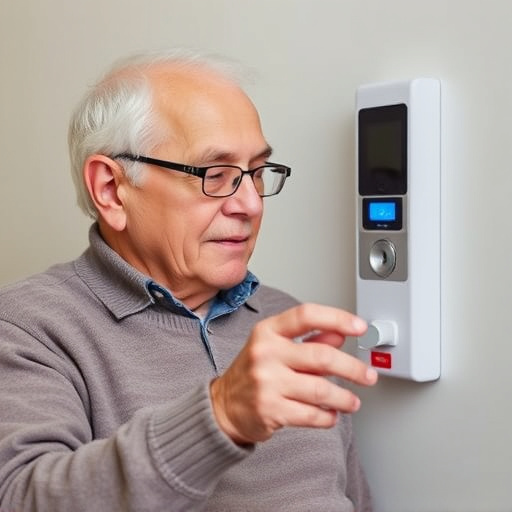Personal alarms for the elderly, also known as panic buttons, are compact yet powerful tools that offer immediate emergency assistance and promote senior independence. These devices connect users directly to emergency services, include advanced features like automatic fall detection and GPS tracking, and provide peace of mind for both seniors and their loved ones. With various options available, personal alarms ensure the safety and well-being of elderly individuals living alone, encouraging an active lifestyle while offering tailored solutions for specific needs. Effective deployment relies on caregiver training and personalized protocols, enhancing care quality and security.
In today’s digital era, ensuring the safety and well-being of our aging population is paramount. The elderly panic button, also known as a personal alarm for seniors, stands as a lifesaving tool offering invaluable peace of mind. These devices empower the elderly to maintain independence while providing caregivers with rapid response capabilities in case of emergencies. From understanding its core functionality to exploring diverse device types and implementation strategies, this article delves into the multifaceted benefits of personal alarms for the elderly.
Understanding the Elderly Panic Button: A Lifesaving Tool
A personal alarm for elderly individuals, often dubbed a panic button, is a lifesaving tool designed to provide immediate assistance in case of emergencies. This compact device offers peace of mind by allowing seniors to discreetly signal for help from anywhere—whether they’re at home, alone, or out and about. A simple press of the button triggers a direct connection to emergency services, ensuring swift response times.
The importance of such devices lies not only in their ability to summon aid but also in their potential to enhance the independence and safety of older adults. With advanced technology, modern panic buttons can be tailored to individual needs, incorporating features like automatic fall detection, GPS tracking, and two-way communication. This comprehensive approach ensures that help arrives promptly, should an elderly person find themselves in a distressing situation, allowing them to live more securely and confidently.
How Personal Alarms Assist Seniors in Daily Life
Personal alarms designed for the elderly play a pivotal role in enhancing their safety and independence in daily life. These compact yet powerful devices are more than just emergency buttons; they become constant companions, offering peace of mind to both seniors and their loved ones. With a simple press or pull, a personal alarm for elderly can instantly connect them to emergency services, ensuring swift response times in case of falls, medical emergencies, or even when they wander off and get lost.
Beyond immediate assistance, these alarms often include features tailored to senior citizens’ needs. They may have fall detection sensors, automatic medication reminders, and GPS tracking capabilities. These additional functions not only address specific concerns but also encourage seniors to maintain an active lifestyle while knowing their well-being is prioritized.
Benefits: Safety, Peace of Mind, and Independence
The implementation of a personal alarm for elderly individuals offers a multitude of benefits, primarily centred around enhanced safety and peace of mind. In many cases, seniors may live alone, and a panic button device provides them with an instant means of summoning help in emergencies. This is especially crucial for those with mobility issues or who take certain medications that could cause dizziness or fainting spells.
Moreover, having a personal alarm promotes independence by assuring elderly folks that they can call for assistance without having to wait for someone to notice their distress. This sense of autonomy allows them to live more confidently and actively participate in daily routines, knowing that help is readily available if needed.
Types of Elderly Panic Devices: Exploring Options
The market offers a variety of elderly panic devices, each designed to cater to specific needs and preferences. One of the most common types is the personal alarm for elderly, often worn as a pendant or built into a mobile device. These alarms are typically equipped with buttons or sensors that, when activated, send out emergency signals to caregivers, family members, or monitoring centers. Some devices even offer fall detection technology, which automatically triggers an alert if the wearer experiences a sudden fall.
Other options include wireless sensors that can be placed around the home and detect unusual activity or movement. Smartwatches with panic buttons are also gaining popularity due to their portability and seamless integration with smartphone apps. These devices allow users to send alerts with just a tap, while some advanced models even offer GPS tracking for precise location identification during emergencies.
Implementation and Caregiver Support for Effective Use
The successful implementation of a personal alarm for elderly individuals relies heavily on caregiver support and training. Caregivers play a pivotal role in ensuring the effective use of these devices, which can be life-saving in emergency situations. They should be educated on how to activate the alarms, interpret different alerts, and respond promptly to ensure the safety and well-being of their charges. Regular practice drills and demonstrations can help familiarize both the elderly person and their caregivers with the system, fostering confidence and a sense of security.
Additionally, caregivers should be encouraged to create personalized emergency protocols tailored to their loved ones’ unique needs and preferences. This may include identifying specific triggers for alarm activation, establishing communication strategies, and knowing when to seek medical assistance. With proper guidance and support, caregivers can transform themselves into adept users of personal alarms, enhancing the overall quality of care and peace of mind for both the elderly and their families.
